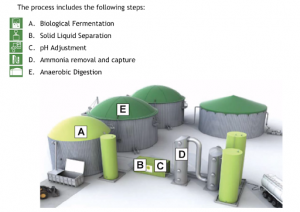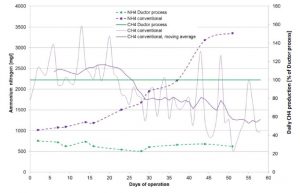DUCTOR Corp. has developed a biological process that separates and captures nitrogen (ammonia) from organic waste streams. The biogas industry is a natural platform for this biotechnology as it solves the problem of ammonia inhibition, which has long bedeviled traditional anaerobic digestion (AD) processes. DUCTOR’s technology allows for stabilized and optimized biogas production from 100% high nitrogen feedstocks (such as poultry manure) and significantly strengthens the economics of biogas facilities: relatively inexpensive inputs, optimized gas production as well as new, higher value revenue streams from the organically produced byproducts—a pure Nitrogen fertilizer and a high Phosphorus soil amendment. DUCTOR’s mission is to promote biogas as a renewable energy source while securing efficient waste management and sustainable food & energy production, supporting the development of circular economies.
Purpose

High concentrations of ammonia in organic waste streams have been a perpetual challenge to the biogas industry as ammonia is a powerful inhibitor of biogas production. In typical methanogenic communities, as ammonia levels exceed 1500mg/L Ammonia-N, the inhibition of methane production begins until it reaches toxic levels above 3000mg/L. Traditionally, various mechanical and chemical methods have been deployed to lower ammonia concentrations in high nitrogen organic feedstocks prior to or following biodigestion (Figure 1). These methods have proven cumbersome and operationally unstable. They either require dilution with often costly supplemental feedstocks, are fresh water intensive, waste valuable nutrients, or require caustic chemicals injurious to the environment. Without the application of these methods, nitrogen levels will build up in the digester and negatively affect the efficiency of biogas (methane) production. DUCTOR’s proprietary process revolutionizes ammonia removal with a biological approach, which not only optimizes the operational and economic performance of biogas production, it also allows for the ammonia to be recaptured and recycled as an organic fertilizer product (a 5-0-0 Ammonia Water). This biotechnical innovation represents a significant advancement in biogas technology.
What did we do?
DUCTOR’s innovation is the invention of a fermentation step prior to the classic anaerobic digestion process of a biogas facility (Figure 2). During this fermentation step in a pre-treatment tank, excess nitrogen is biologically converted into ammonia/ammonium and captured through a physical process involving volatilization and condensation of the liquid portion of the digestate.

We ran a demonstration biogas facility with these two steps in Tuorla, Finland for 2000 hours using 100% poultry litter as fermenter feedstock without experiencing ammonia inhibition of the methanogenesis process. While the control, a single-stage traditional digester, showed increased buildup of toxic ammonia, the fermented material coming out of the first stage of the DUCTOR process (having ~50-60% of its nitrogen volatilized and removed) exhibited uniform levels of nitrogen below the inhibition threshold (Figure 3). This allowed a stable and efficient digestion by the methanogenic microbial community in the second stage digester. The fermentation step effectively eliminates the need for co-digestion of poultry manures with other higher C/N ratio substrates.

What we have learned?
In addition to solving the problem of ammonia inhibition, DUCTOR’s innovation realizes the separation of valuable recycled nutrients in a manner that can produce additional revenue streams. The result of the fermentation process in the first stage digestion tank is an organically produced non-synthetic ammonia (NH4OH), which is condensed and collected. This ammonia water product can be marketed and sold as an organic fertilizer as it is the result of a completely biological process with no controlled chemical reactions. The non-synthetic ammonia produced comes from the digestion of poultry litter by ammonifying microorganisms in anaerobic conditions. Furthermore, this ammonia water is in a plant available form that can be metered onto fields based on crop demands and thus reduce the amount of excess nitrates leaching into the water table and surrounding watershed.
The solids byproduct that results from the completion of the anaerobic digestion process has a large fraction of phosphorus and potash. This digestate can be dried and pelleted to produce a high-phosphorus soil amendment. While recognizing demand for this product would vary by region based on existing phosphorus levels in the soil, it offers a transportable & storable way to return these valuable elements to the nutrient cycle.
Finally, the importance of gas production as a form of sustainable, renewable energy cannot be understated. With 2/3rds of the world’s greenhouse gas emissions coming from the burning of fossil fuels for energy or electricity generation,1 biogas derived from anaerobic digestion can displace some of those processes and reduce environmental greenhouse gas emissions.2 Currently, there are many state and federal policies focusing on renewable energy credits and low carbon fuel standards to incentivize this displacement.3 With the ability to unlock poultry litter as an additional AD feedstock, biogas facilities can offer greater volumes of biogas production per ton of manure than either dairy or swine.
Future plans
We have several commercial projects that will feature the DUCTOR technology at various stages of development in North America. The demonstration facility at Tuorla has been disassembled and shipped to Mexico where it will be reassembled as part of a larger commercial project there. In cooperation with our Mexican partner, we will demonstrate successful operations under a new set of conditions, including different climate and a new source of poultry litter from different regional growing practices. We further intend to demonstrate the highly efficient water use of the process in a drought-prone area.
Additionally, we have received approval from the North Carolina Utilities Commission for entry into their pilot program for injecting biomethane into North Carolina’s natural gas pipelines. Our first project there is expected to begin construction in Spring 2019 to be completed and operational by early 2020. These projects, and others in development, will bring a very attractive and new manure management option to poultry farmers, while recycling nutrients from the waste stream and returning them to the soil in a measurable and sustainable manner.
Author
Bill Parmentier, Project Development, DUCTOR Americas
Additional information
1Global Greenhouse Gas Emissions Data, US Environmental Protection Agency (EPA), https://www.epa.gov/ghgemissions/global-greenhouse-gas-emissions-data
2Sources of Greenhouse Gas Emissions, US Environmental Protection Agency, https://www.epa.gov/ghgemissions/sources-greenhouse-gas-emissions
3Methane is a potent greenhouse gas that is over 20 times more damaging on the environment than carbon dioxide. Anaerobic digestion stops the release of methane into the environment by capturing it and using it for energy production or transportation fuel.
Federal incentives include the Rural Energy for America Program (REAP), Alternative Fuel Excise Tax Credit, & Federal Renewable Energy Production Tax Credit to name a few. Examples of state level incentives include various states Renewable Portfolio Standards (RPS) as well as California’s Low Carbon Fuel Standard (LCFS) or Oregon’s Clean Fuels Standard (CFS).
The authors are solely responsible for the content of these proceedings. The technical information does not necessarily reflect the official position of the sponsoring agencies or institutions represented by planning committee members, and inclusion and distribution herein does not constitute an endorsement of views expressed by the same. Printed materials included herein are not refereed publications. Citations should appear as follows. EXAMPLE: Authors. 2019. Title of presentation. Waste to Worth. Minneapolis, MN. April 22-26, 2019. URL of this page. Accessed on: today’s date.


